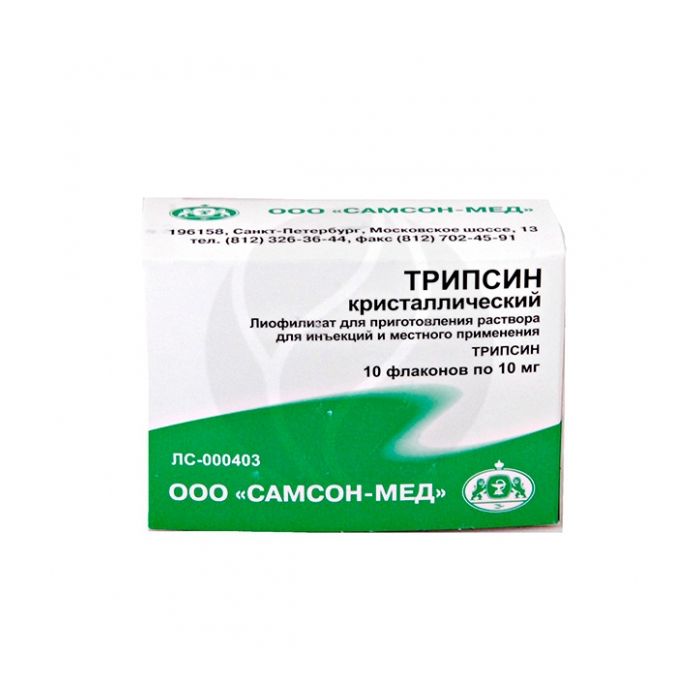Trypsin crystalline lyophilisate 10mg, No. 10
Expiration Date: 11/2025
Russian Pharmacy name:
Трипсин кристаллический лиофилизат 10мг, №10
bronchiectasis;
lung abscesses;
exudative pleurisy;
postoperative atelectasis;
empyema of the pleura;
treatment of purulent wounds and burns;
chronic purulent otitis media;
purulent sinusitis, sinusitis;
acute thrombophlebitis;
acute and chronic odontogenic osteomyelitis;
inflammatory-dystrophic forms of periodontal disease;
acute irides and iridocyclitis;
hemorrhages in the eye chamber and edema of the periorbital tissues after injuries and operations;
obstruction of the lacrimal passages.
Crystalline trypsin is used i / m, interpleurally, in the form of aerosols and electrophoresis.
V / m: adults 0.005-0.01 g 1-2 times / day, children 0.0025 g 1 time / day. For injection, immediately before use, 0.005 g of crystalline trypsin is diluted in 1-2 ml of 0.9% sodium chloride solution or 0.5-2% procaine solution. The course of treatment is 6-15 injections. Electrophoresis with trypsin is also used: for one procedure, 10 mg of trypsin (dissolve in 15-20 ml of distilled water) is injected from the negative pole.
Inhalation: 0.005-0.01 g in 2-3 ml of 0.9% sodium chloride solution through an inhaler or through a bronchoscope. After inhalation, rinse your mouth with warm water and rinse your nose.
Eye drops: 0.2-0.25% solution, which is prepared immediately before use, 3-4 times / day for 1-3 days.
Intrapleural: 1 time / day 10-20 mg of the drug, dissolved in 20-50 ml of 0.9% sodium chloride solution, after administration, a frequent change in body position is desirable; on day 2 after installation, as a rule, a liquefied exudate is released.
Topically: in the form of a powder or solution, compresses are applied to dry or necrotic wounds (the solution is prepared immediately before use: 50 mg of trypsin is dissolved in 5 ml of sterile water or saline, in the treatment of purulent wounds - in 5 ml of phosphate buffer solution). A three-layer woven fabric made of dialdehyde cellulose, impregnated with trypsin, is applied to the wound (after its processing) and fixed with a bandage, left on the wound for no more than 24 hours. Before use, the fabric is moistened with distilled water or a solution of furacilin. The time for complete cleansing of the wound from necrotic tissue and pus is 24-72 hours. If necessary, reapply.
crystalline trypsin * 10 mg
heart failure;
pulmonary emphysema with respiratory failure;
decompensated form of pulmonary tuberculosis;
dystrophy and cirrhosis of the liver;
infectious hepatitis;
kidney damage;
pancreatitis;
hemorrhagic diathesis;
hypersensitivity.
pharmachologic effect
Crystalline trypsin is an enzyme preparation of proteolytic action, obtained from the pancreas of cattle.
Trypsin has pronounced anti-inflammatory and decongestant properties, is able to break down dead tissue, fibrinous formations, viscous secretions and exudates. In relation to healthy tissues, the enzyme is inactive and safe due to the presence of trypsin inhibitors (specific and nonspecific) in them. Does not affect the hemostatic system.
Indications of the drug Trypsin crystalline
bronchiectasis;
lung abscesses;
exudative pleurisy;
postoperative atelectasis;
empyema of the pleura;
treatment of purulent wounds and burns;
chronic purulent otitis media;
purulent sinusitis, sinusitis;
acute thrombophlebitis;
acute and chronic odontogenic osteomyelitis;
inflammatory-dystrophic forms of periodontal disease;
acute irides and iridocyclitis;
hemorrhages in the eye chamber and edema of the periorbital tissues after injuries and operations;
obstruction of the lacrimal passages.
Side effect
Allergic reactions, fever, tachycardia.
Local reactions: soreness and hyperemia at the injection site with intramuscular injection. Inhalation of trypsin may cause irritation of the mucous membranes of the upper respiratory tract and hoarseness.
Contraindications for use
heart failure;
pulmonary emphysema with respiratory failure;
decompensated form of pulmonary tuberculosis;
dystrophy and cirrhosis of the liver;
infectious hepatitis;
kidney damage;
pancreatitis;
hemorrhagic diathesis;
hypersensitivity.
Application during pregnancy and lactation
It is possible only if the expected benefit for the woman outweighs the possible risk for both the woman and the child.
Application for violations of liver function
Contraindicated in dystrophy and cirrhosis of the liver, infectious hepatitis.
Application for impaired renal function
Contraindicated in renal impairment.
Application in children
It is used according to indications.
special instructions
The drug should not be injected into the foci of inflammation and bleeding cavities.
You can not enter the drug in / in.
Trypsin should not be applied to the ulcerated surfaces of malignant tumors in order to avoid the spread of the malignant process.
Drug interactions
Only with inhalation can bronchodilators and antibiotics be added to the solution.

